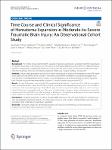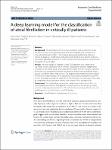Search
Author
- Daqing, Ma (3)
- Alexis, Ferré (2)
- Anna, Lybeck (2)
- Ashish K., Khanna (2)
- next >
Subject
- intensive care unit (8)
- acute respiratory dist... (5)
- chronic obstructive pu... (5)
- ICU (5)
- next >
Has File(s)
Search Results
Preventing intracranial hematoma expansion has been advertised as a possible treatment opportunity in traumatic brain injury (TBI). However, the time course of hematoma expansion, and whether the expansion affects outcome, remains poorly understood. In light of this, the aim of this study was to use 3D volume rendering to determine how traumatic intracranial hematomas expand over time and evaluate its impact on outcome. |
To observe if blood return, also defined as the blood infusion test (BIT) could predict fluid responsiveness in critically ill patients with acute circulatory failure and renal replacement therapy (RRT). |
The importance of treating severely injured patients in higher-level trauma centers is undisputable. However, it is uncertain whether severely injured patients that were initially transported to a lower-level trauma center (i.e., undertriage) benefit from being transferred to a higher-level trauma center. |
Evidence for a hospital volume–outcome relationship in hip fracture surgery is inconclusive. This study aimed to analyze the association between hospital volume as a continuous parameter and several processes and outcomes of hip fracture care. |
Propofol is considered an excellent intravenous anesthetic agent. However, a 30–70% incidence of pain associated with its injection is a significant source of patient discontent. Injection pain and discomfort rank as the sixth most crucial perioperative issue (Desousa 2016). Several techniques have been employed to reduce injection discomfort, including the use of the forearm and antecubital veins, freezing or warming the injectate, and aspirating blood before injection. Pre-treatment or contemporaneous administration of thiopentone, pethidine, fentanyl, dexamethasone, nitroglycerine, ketorolac, and local anesthetics has also been considered. |
Damage control orthopaedics (DCO) und early total care (ETC) are well-established strategies for managing severely injured patients. There is no definitive evidence of the superiority of DCO over ETC in polytrauma patients. We conducted this study to assess the probability of a polytraumatised patient undergoing DCO. In addition, the effect of DCO on complications and mortality was investigated. |
In military trauma, disaster medicine, and casualties injured in remote locations, times to advanced medical and surgical treatment are often prolonged, potentially reducing survival and increasing morbidity. Since resuscitation with blood/blood components improves survival over short pre-surgical times, this study aimed to evaluate the quality of resuscitation afforded by blood/blood products or crystalloid resuscitation over extended ‘pre-hospital’ timelines in a porcine model of militarily relevant traumatic haemorrhagic shock. |
High ratio of the carbon dioxide veno-arterial difference to the oxygen arterial-venous difference (PvaCO2/CavO2) is associated with fluid bolus (FB) induced increase in oxygen consumption (VO2). This study investigated whether PvaCO2/CavO2 was associated with decreases in blood-lactate levels FB in critically ill patients with hyperlactatemia. |
Using computer simulation we investigated whether machine learning (ML) analysis of selected ICU monitoring data can quantify pulmonary gas exchange in multi-compartment format. A 21 compartment ventilation/perfusion (V/Q) model of pulmonary blood flow processed 34,551 combinations of cardiac output, hemoglobin concentration, standard P50, base excess, VO2 and VCO2 plus three model-defining parameters: shunt, log SD and mean V/Q. |
Atrial fibrillation (AF) is the most common cardiac arrhythmia in the intensive care unit and is associated with increased morbidity and mortality. New-onset atrial fibrillation (NOAF) is often initially paroxysmal and fleeting, making it difficult to diagnose, and therefore difficult to understand the true burden of disease. Automated algorithms to detect AF in the ICU have been advocated as a means to better quantify its true burden. |










